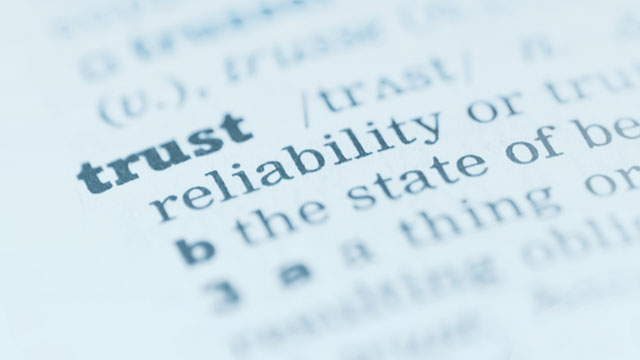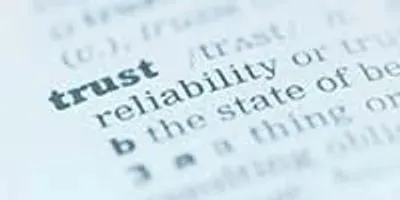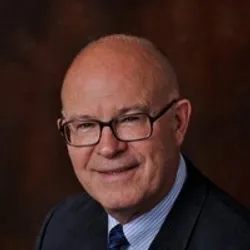
A Leader's Personal Courage and Honest Communcation are Essential
In each case, a high degree of trust will likely be necessary for those involved to benefit.
Yet today we observe a crisis in trust—a crisis that results largely from the breakdown of effective communication. From family relationships to academic and business settings, rashly developed and poorly delivered communication fuels a growing lack of trust.
There is, however, a bright side. Two Chinese characters represent the word for “crisis”: the first, “wei,” describes “danger”; the second, “ji,” means “opportunity.” So the combination of these two Chinese characters suggests that any crisis provides both danger and opportunity. The crisis in trust that has resulted from poor or ineffective communications provides an opportunity to improve those communications, thus increasing “trust conductivity.”
What is “trust conductivity,” and why is it essential to building a high-trust organization?
Whereas electrical conductivity is the ease with which a current passes through a wire (conductor) to produce power, “trust conductivity” describes the ease with which trust passes through an organization, providing the power to meet projections and reach goals. With electricity, the better the conductor, the larger the current; with trust, the better the communication, the greater the flow of trust. Electrical current is driven by a source of electricity, which is generally accessed by flipping a switch. But how is trust driven, and what is its energy source?
A leader must provide the energy needed to drive the flow of trust through his communications. However, to access this energy, that leader must first “flip the switch,” turning on personal courage. That courage enables him to take advantage of the opportunity to increase trust by communicating clearly.
So trust conductivity is highly dependent on good communication, but everything starts with courage. Why? As Maya Angelou said, “Without courage, we cannot practice any other virtue with consistency.” She then enumerated some of those “other virtues” by adding, “We cannot be kind, true, merciful, generous, or honest without courage.”1
Yes, courage taps the potential for displaying such fine qualities as kindness, generosity, and honesty in our dealings with others, thereby increasing trust.
On the other hand, resistance to the free flow of communication lowers trust conductivity within an organization. Much as resistance in an electrical circuit inhibits the flow of current and produces a quantum “friction” that manifests itself as heat, communication that inhibits the free flow of trust acts as a resister that produces a friction of its own. That friction, too, can manifest itself as “heat,” perhaps in the form of heated arguments and flaring tempers in response to poorly communicated messages. As a result, it takes more energy, more pressure, or more effort to overcome resistance and provide the clear direction that ensures the flow of trust.
To understand more specifically how communication affects the flow of trust, we will first examine three types of communication that resist trust, and then we will consider five ways to increase the flow of trust in an organization.
Trust resister #1: Dishonest communication
Dishonest communication results primarily from a lack of courage. It presents primarily in two forms: hiding the truth and not accepting the truth.
While hiding the truth might involve an outright lie concerning facts or pertinent information, avoiding the truth often reveals an unwillingness to face reality. To illustrate, imagine a company launching a revolutionary product that does not perform as well as marketing suggests. Executives and leaders know it is not performing but lack the courage to delay its release until all the “bugs” are worked out. When multiple performance issues begin to surface, customers become frustrated and trust rapidly erodes.
A leader must courageously demonstrate a grasp of reality; even in the most challenging situations, we can communicate honestly and still express faith that difficulties will be overcome.
Trust resister #2: Complex and deceptive communication
Communications must be clear, without underlying motives or hidden agendas. If the explanation offered is designed simply to mislead, confuse, or give credit where credit is not due, trust will surely falter. For example, communicating that a worker has left your organization because she found a better job when in fact she was fired is deceptive.
Trust resister #3: Unsupportable conviction or a lack of conviction
Friedrich Nietzsche said, “Convictions are more dangerous enemies of truth than lies.” If we have a conviction on a particular topic and it happens to be wrong, it quickly becomes an unfounded assumption. To stubbornly hold to that assumption will certainly impede the flow of trust.
On the other hand, having no conviction can cause us to flip-flop on issues. Trust is not built on the backs of leaders who lack the courage to commit to a course of action and communicate it effectively.
Not being committed to the vision of an organization, or simply not understanding it, will destroy trust. Effective leaders who do their homework seldom suffer from a lack of conviction and the loss of trust that engenders.
What positive action can we take to build and maintain trust? Consider these five ways to increase trust conductivity:
Trust conductor #1: Tell the truth, always
The truth can be hard to face and hard to communicate when a lot is at stake.
However, consider the alternative offered by twentieth-century American writer Ti-Grace Atkinson: “There is at least one thing more brutal than the truth, and that is the consequence of speaking less than the truth.”
Why is this so? Because, as the popular saying goes, “One lie destroys a thousand truths.” Unfair as it may seem, we know this to be true. Trust is intimately tied to how truthful a person is.
We can greatly increase the flow of trust across an organization if we always tell the truth. Once acquired, such trust must be maintained. Just as a strong electrical current requires a grounding wire, a high level of trust must stay grounded in leadership & staffing continued honesty. We might be tempted to reason, “This is a small thing, so no one needs to know the truth…” Don’t be fooled—people on your team can easily discern when your lack of courage results in communication crafted to protect yourself, elevate yourself, or absolve yourself of responsibility.
Another form of dishonesty presents itself in the form of hypocrisy. The Greek word for “hypocrite” refers to a stage actor, meaning one who pretends to be what he is not. Others notice when we advocate one course and do the opposite; failing to practice what we preach short-circuits trust.
Closely related to dishonesty is “spin”: intentionally trying to shape the understanding or perception of facts. For example, to say that our leadership improved their performance by 11 percent hides the truth that very little improvement has resulted. Computer giant Dell notes in its Code of Conduct, “What we say is true and forthcoming—not just technically correct.”2
Ask yourself: “Am I telling the full truth, or am I “spinning” it to make a situation appear different from how it really is? What do I believe? Am I telling it that way—am I communicating it clearly?” Avoid spin, as it will surely choke the flow of trust.
Finally, Mark Twain summarized one additional reason we should always speak honestly: “If you tell the truth, you don’t have to remember anything.” If we are honest with those around us, we won’t need to try to remember what we last said in a meeting.
Trust conductor #2: Build and maintain respect for the dignity of others
At times, building respect for others can prove challenging. Yet when we respect the dignity of others—for example, by bringing them into our office and sincerely reassuring them that they are doing a good job—we are helping create a deep and abiding trust within our team.
Leaders in any organization do well to remember another insightful observation offered by Maya Angelou: “I’ve learned that people will forget what you said, people will forget what you did, but people will never forget how you made them feel.”
Maintain a two-way dialogue in team discussions and within the organization; be inclusive in your speech, and share the blame when appropriate. Provide a sense of safety, assuring team members they will never be punished for telling the truth or giving an honest opinion. Be generous with praise, and limit criticism. Look for the good things your team does and commend them warmly. The mutual respect that results will provide a steady flow of trust that will benefit everyone.
Trust conductor #3: Address past sins—real or perceived
We all make mistakes, and overlooking or hiding those mistakes is one of the worst things a leader can do.
If your mistake causes hard feelings, humbly offer a sincere apology: not saying, “Well, I am sorry you feel that way” (which, in reality, skirts personal responsibility) or “I’m sorry you got your feelings hurt (which subtly puts the responsibility back on the offended), but rather accepting personal responsibility and perhaps simply saying, “I’m sorry I hurt your feelings. I was wrong.”
But suppose you learn that some time ago you unknowingly offended someone. What steps can you take? First, lose the ego; don’t stubbornly stick to your position. Be quick to apologize, with a view to restoring peace and moving on. Keep in mind that a poor or forced apology is generally regarded as a second insult, and your level of sincerity will either build trust or destroy it.
Finally, a leader creates the path forward following any crisis in communications. By personal example, show others how to get past the issue. It may require humility, expressing in a kind and mild way a keen desire to let go of any negative feelings yourself and move forward. As Napoleon Bonaparte said, “Leaders are dealers in hope.” So paint a positive picture for moving forward, and be firmly resolved not to hold or hide a grudge.
Trust conductor #4: Stabilize the crisis situation
Try using the three “Cs”: Calm, Commend, and Contain. When meeting a difficult challenge, lower the stress level by remaining Calm in speech and action. Begin any discussion by first Commending the individual(s) involved—this will relieve tension, making everyone more receptive to a productive outcome. Finally, Contain your emotions. Even if something unexpected happens, perhaps an insult or an unkind remark, control your desire to lash out or retaliate.
Trust conductor #5: Communicate your trust in others
We need to be sincere and specific in communicating the trust we have in others. As Bill Walsh, the legendary NFL coach of the San Francisco 49ers, said, “Nothing is more effective than sincere, accurate praise, and nothing is more lame than a cookie-cutter compliment.”
Trust can also be subtly communicated by listening well. Discipline yourself to listen more than you speak. As Stephen R. Covey so accurately observed, “Most people do not listen with the intent to understand. They listen with the intent to reply.”3 Listen to what others express, and then pause to formulate a reply based on what was said. This will surely increase the flow of trust.
What will it take on our part to build trust in the organization? Courage and action. It all begins with personal courage: courage to communicate when it is easier to remain silent. Courage to make honesty nonnegotiable. Courage to address issues early on and not let problems fester. Courage to be human and communicate how you feel. John Wayne said, “Courage is being scared to death and saddling up anyway.” So, saddle up, managers, and communicate!
References
- Interview in USA Today, March 5, 1988.
- Dell, Inc., “Our Ethical Principles.”
- “The 7 Habits of Highly Effective People: Powerful Lessons in Personal Change.” Stephen R. Covey, Habit 5, p. 251.
A Leader's Personal Courage and Honest Communcation are Essential
In each case, a high degree of trust will likely be necessary for those involved to benefit.
Yet today we observe a crisis in trust—a crisis that results largely from the breakdown of effective communication. From family relationships to academic and business settings, rashly developed and poorly delivered communication fuels a growing lack of trust.
There is, however, a bright side. Two Chinese characters represent the word for “crisis”: the first, “wei,” describes “danger”; the second, “ji,” means “opportunity.” So the combination of these two Chinese characters suggests that any crisis provides both danger and opportunity. The crisis in trust that has resulted from poor or ineffective communications provides an opportunity to improve those communications, thus increasing “trust conductivity.”
What is “trust conductivity,” and why is it essential to building a high-trust organization?
Whereas electrical conductivity is the ease with which a current passes through a wire (conductor) to produce power, “trust conductivity” describes the ease with which trust passes through an organization, providing the power to meet projections and reach goals. With electricity, the better the conductor, the larger the current; with trust, the better the communication, the greater the flow of trust. Electrical current is driven by a source of electricity, which is generally accessed by flipping a switch. But how is trust driven, and what is its energy source?
A leader must provide the energy needed to drive the flow of trust through his communications. However, to access this energy, that leader must first “flip the switch,” turning on personal courage. That courage enables him to take advantage of the opportunity to increase trust by communicating clearly.
So trust conductivity is highly dependent on good communication, but everything starts with courage. Why? As Maya Angelou said, “Without courage, we cannot practice any other virtue with consistency.” She then enumerated some of those “other virtues” by adding, “We cannot be kind, true, merciful, generous, or honest without courage.”1
Yes, courage taps the potential for displaying such fine qualities as kindness, generosity, and honesty in our dealings with others, thereby increasing trust.
To continue reading this article, sign up for FREE to

Membership is FREE and provides you with instant access to eNewsletters, digital publications, article archives, and more.













